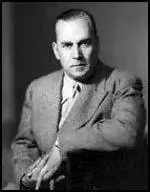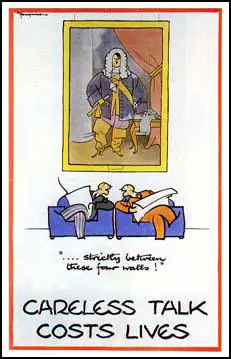Cyril Bird (Fougasse)

Cyril Bird, the son of the England cricketer, Arthur Bird, was born in Cheltenham on 17th December 1887. After attending Cheltenham College (1902-04), Bird he studied engineering at King's College and took art classes at Regent Street Polytechnic and the Bolt Court School of Photo-Engraving.
In 1904 he became a machine-gun instructor in the Artists' Rifles. Later he was employed at the Rosyth Naval Dockyard (1909-1914). On the outbreak of the First World War he became an officer in the Royal Engineers. He reached the rank of lieutenant when he was blown up by a shell at Gallipoli in 1915. His injuries were so bad he was not expected to survive.
Invalided out of the British Army, Bird's cartoons first appeared in Punch Magazine in 1916. He used the name Fougasse (a type of French anti-personnel mine) to avoid confusion with another Punch contributor W. Bird (Jack B. Yeats). Bird later recalled that his cartoons were like the fougasse "its effectiveness is not always reliable and its aim uncertain". Bird also contributed to The Bystander, The Daily Graphic, The Tatler, London Opinion and The Sketch.
Bird's style was notable for what one critic called its "pronounced linear simplicity." Like Henry Mayo Bateman, another cartoonist who worked for Punch Magazine during the war, Bird often adopted an episodic format. Mark Bryant pointed out that at first he drew like Bert Thomas "but gradually developed his own style (motoring and radio being frequent subjects)."
Bird became Art Editor of Punch Magazine in 1937 and during the Second World War designed several posters for various government departments including his famous Careless Talk Costs Lives series for the Ministry of Information depicting Adolf Hitler listening to conversations. For this work he was awarded the honour of Commander of the Order of the British Empire in 1946.

It has been argued that Bird pioneered the idea that humour is more important than art. He once said that "it is really better to have a good idea with a bad drawing than a bad idea with a good drawing". According to Mark Bryant: "His distinctive, strikingly economical style, often using only a few lines but expressing great dynamism, is immediately recognizable and has influenced many artists."
R.G.G. Price, the author of A History of Punch (1957) has argued that "clarity and speed were everything in his work and he was constantly trying to simplify... he rapidly developed a personal style that was perhaps the first introduction of advertising technique to the editorial pages of Punch."
In 1949 Bird was appointed editor of Punch Magazine. He was the first cartoonist to be given this position and held the post until his retirement in 1953.
Cyril Bird, who was married to the watercolour artist, Mary Holden Caldwell, died on 11th June 1965.
